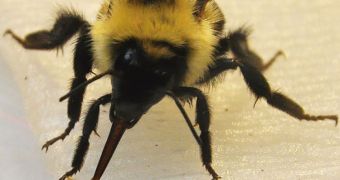Massachusetts Institute of Technology (MIT) investigators have determined in a new study that bees reach their peak performance when gathering nectar and pollinating planets if they come across nectar that is viscous and high in sugar contents.
The insects have the tendency to probe what the plant has to offer with their tongues, which is why researchers refer to them as viscous dippers. Their counterparts are suction feeders, creatures such as most birds and butterflies, who use tubes to suck the nectar out.
In the natural world, being able to display high efficiency in feeding could very well represent the boundary between life or death. As far as bees go, the most efficient ones are also the ones less likely to be consumed by predators, and the less prone to failure.
Interestingly, the research team that conducted the new work appears to believe that this type of natural setup points to the existence of a co-evolutionary process between flowers and their pollinators, at least for some species, if not all.
“Do the flowers want a certain type of bug or bird to pollinate them? And are they offering up the nectar of their preferred pollinator?. It’s an interesting question whether there’s a correlation between the morphology of the plant and the morphology of the insect,” researcher John Bush says.
The work was carried out by mathematicians at MIT, who were led by Bush. The expert himself is a professor of applied mathematics at the Institute. Details of the new research were published in the latest issue of the esteemed journal Proceedings of the National Academy of Sciences (PNAS).
The team leader says that the uptake mechanisms insects and birds use for collecting nectar can be likened to either a spoon or a straw. Naturally, it's easier to drink sugar water through a straw than it is to suck up molasses.
At the same time, a spoon is better for collecting honey. What will be interesting to determine is whether the type of nectar a flower plant displays is influenced in any way by the types of insects that have historically been available to pollinate it.
If such a connection can be demonstrated, then it would signify that the natural world is considerably more intertwined than previously thought. Such a finding would also provide some insights into why several species of plants, birds and insects evolved in the patterns they did.

 14 DAY TRIAL //
14 DAY TRIAL //